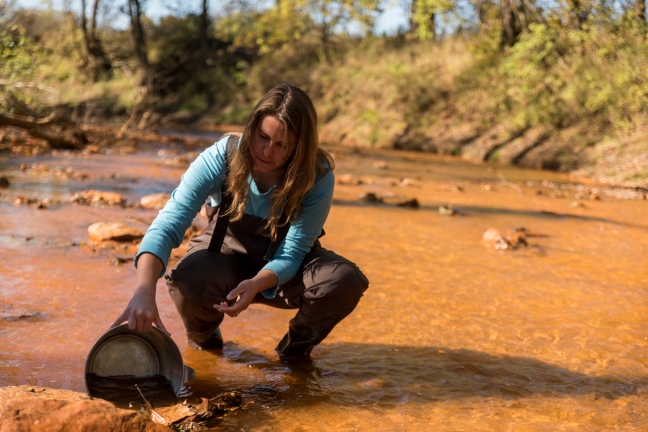
Michelle Shively, Rural Action’s water technician coordinator, gathers water samples from Sunday Creek behind the Athens County Dog Shelter in Chauncey, Ohio on Tuesday, Oct. 20, 2015.
Story and photos by Sophia Vancouver
Tomato-colored water meandered past the Athens County dog shelter, bubbling over rocks and getting caught in iron coated leaves while on its way to the Hocking River. Sunday Creek, a tributary of the Hocking River, is 27 miles long, traveling north to south along the southeastern side of Ohio. It surfaces in Perry County where it passes through the communities of Rendville, Corning, Glouster, Trimble, Jacksonville, and Millfield.
An Acid Mine Drainage (AMD) discharge located along Sunday Creek has produced over one thousand gallons per minute of AMD. According to Michelle Shively, water technician coordinator for the Rural Action Group, “It kills seven miles of Sunday Creek.”
Rural Action is a nonprofit organization that has worked to create a more sustainable environment. It launched multiple projects, one of which had the goal of restoring the Sunday Creek Watershed to make it a livable place for fish and bugs after AMD from abandoned mines polluted the creek.
“The work that we’re doing is all in areas that are associated with mines that were abandoned before 1977 and there were no regulations and no laws…So no one is really held responsible for those areas, which is why we take them on as a nonprofit,” explained Shively.
Unlike the Animas River spill near Durango, Colorado where a gold mine that has been inactive since 1920 spilled 3 million gallons of toxic mining waste into the river causing it to turn the color of tomato soup almost instantly, Sunday Creek AMD has been around since mines were abandoned over 40 years ago. The local community members have gotten used to the color and quality of their water streams, which has made it a challenge for Rural Action to raise funding for their project. In spite of this, the group raised some funds and has slowly improved the water quality within the Sunday Creek Watershed area.
At present, Rural Action has only been able to do minimal work to stop AMD from happening in the first place. If the group has a chance to prevent AMD from occurring, they would resort to a “reclamation project” where the members would either fill in the subsidence hole that leads to the mine or change the course of the river by making a new path of least resistance for the water to travel along; thus, preventing water from being polluted in the first place. However, most of their work is treating already contaminated water.
Sunday Creek had three different types of water treatment systems created along its bank. Homer Elliott, a second-year Rural Action AmeriCorps member, who worked closely with multiple restoration sites along Sunday Creek, explained that Sunday Creek had a Doser installed in it at Pine Run, which is a big metal object that looks like a silo. It was filled with limestone and as water from a nearby tributary filled a bucket in the Doser, the bucket tipped over and the water mixed with limestone. The limestone has a very basic pH level and counteracts the high acidic levels of the polluted water. “All the right conditions have to be there. We have to have enough space,” stated Elliott.
The Doser would create what is called a “dead zone.” “There is so much lime going into the water at the point of the Doser that it becomes too alkaline for life,” stated Shannon Stewart, a Rural Action AmeriCorps member back in 2013, but now works directly through Rural Action. “It kind of looks like lasagna.” For this reason Rural Action chose a place along the creek that was already too far gone for life, so that water further down stream could become healthy enough to sustain life.
Another treatment method Rural Action used is a limestone leach bed. This was essentially a pit with baffles to direct the water around and then the pit is filled with limestone.
The last method Rural Action used to address water pollution within the Sunday Creek watershed was a constructed wetland: where water flows slowly through plants, like cattails. The plants capture metal sediment thus letting the water flow out clean.
“When Rural Action started working with Sunday Creek there were only several species of pollution tolerant fish in there and now there are close to 40 species and certain ones hadn’t been found in the main stem [of the creek] for years,” said Elliott. Rural Action employees and volunteer’s stunned fish once a year to learn if new species had migrated further into the creek by counting the fish population. This method did not hurt or kill the fish. They also used dip nets or kick nets to count the bug populations to determine if any new species of bugs had established. “We found something new that I had never seen before. I never actually knew there were fresh water limpets,” said Elliott, happily.
Residents that lived along Sunday Creek noticed a difference in water quality as a result of all these efforts by Rural Action. “I was outdoorsy when I was a kid, and I would have liked to play in the creek, but my parents always told me not to. There wasn’t anything growing in it anyway,” said Callie Blazier, a Hocking College student studying wildlife Biology. She lived along Sunday Creek from 2002-2005. “Visiting Sunday Creek again recently, I’ve noticed that the water quality has improved and there are more living organisms.”
Mitchell Farley lived along Greens Run, a tributary to Sunday Creek, for 33 years. He worked for 35 years to reclaim abandoned coalmines in southeastern Ohio. During his time living near Sunday Creek he noticed “a substantial change for the better. Improvement in water quality, aquatic life, and the appearance of the stream.”
Although there has been a significant improvement in quality of water, Sunday Creek still has a long way to go. Shively recently tested the water near Athens County Dog Shelter where the water was still very orange. The creek’s conductivity at that location was up to 1275 micro-Siemens per centimeter (the amount of iron in the water was very high in that location). It must be less than 500 to sustain life. In addition, the pH level was 4.6; too acidic for living organisms. Most plant and water ecosystems are healthiest when acidic levels are between 6.5 – 7 pH.
Coalmines had positive effects on the environment too. The abandoned mines became homes to many bats in the area. Because humans are not allowed in the old mines, bats are protected from acquiring diseases such as White Nose Syndrome from humans.
But thanks to the efforts of Rural Action, Sunday Creek and other Rural Action watersheds have been slowly coming back to life. It will take continued funding, time, and effort to completely clear the creeks of AMD though. For more information visit www.watersheddata.com.
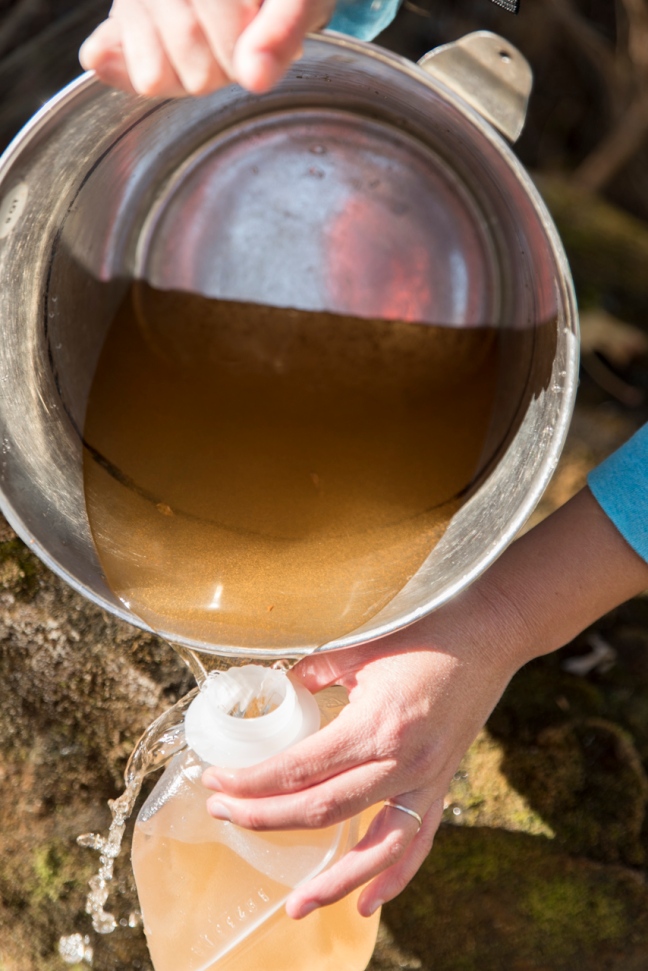
Michelle Shively pours water from Sunday Creek into a plastic container to save as a water sample on Tuesday, Oct. 20, 2015.
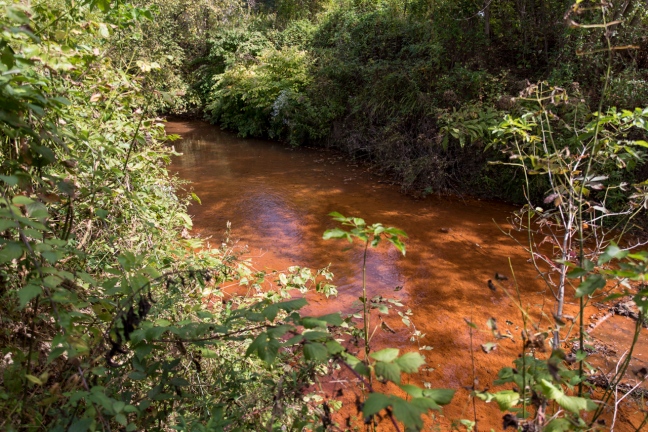
Sunday Creek on Friday, Sept. 25, 2015.
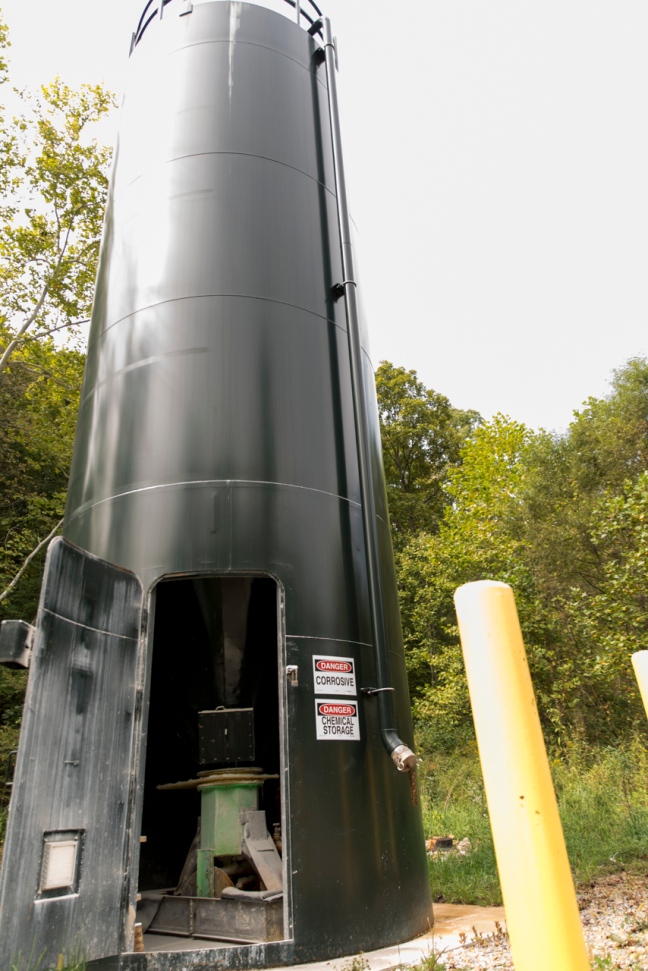
The Pine Run Doser is used to help rid Sunday Creek of iron by mixing it with limestone.
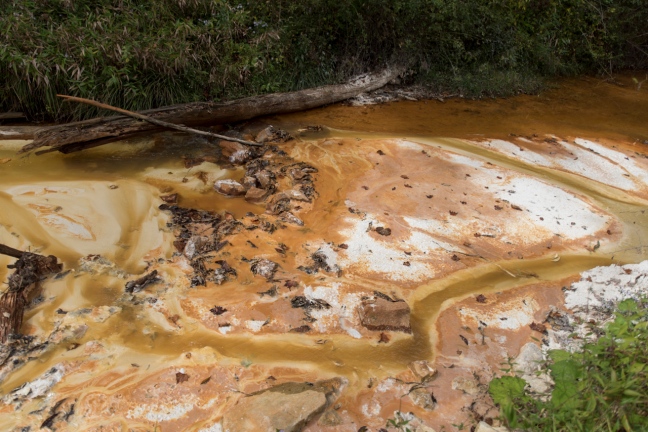
“The dead zone” or the part of the creek behind the Pine Run Doser where limestone, aluminum and iron mix.
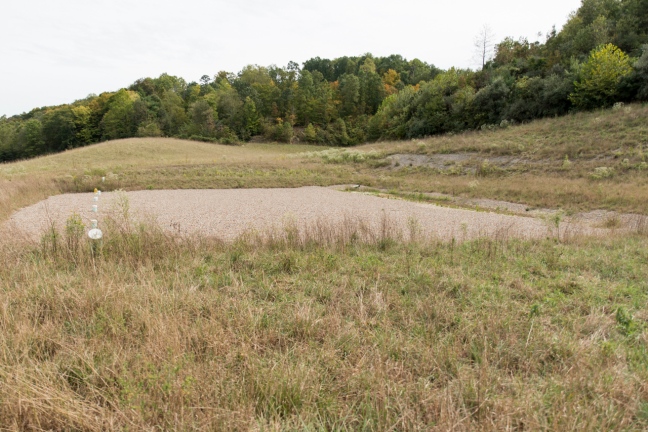
Sunday Creeks limestone leach bed.

The top half of the watershed’s constructed wetland. Water runs over a cement mattress to help put oxygen into the water before it reaches the constructed wetland (below) where the cattails and other plants that help catch the iron before the water reaches the creek.
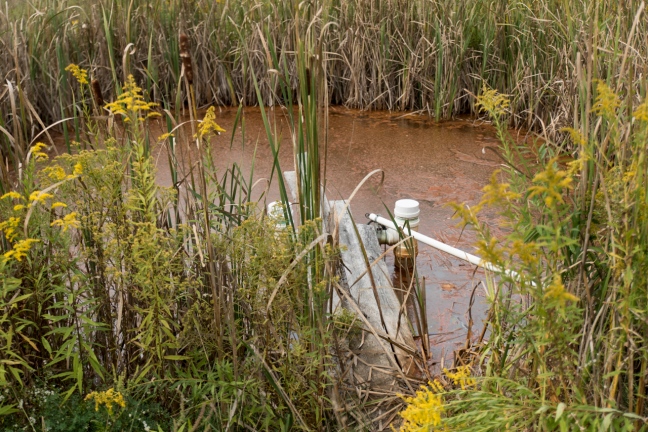
Bottom half of the constructed wetland created for Sunday Creek.